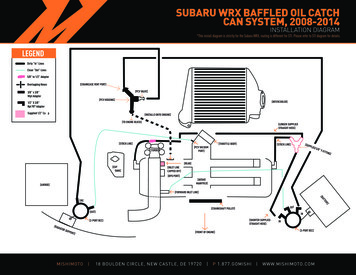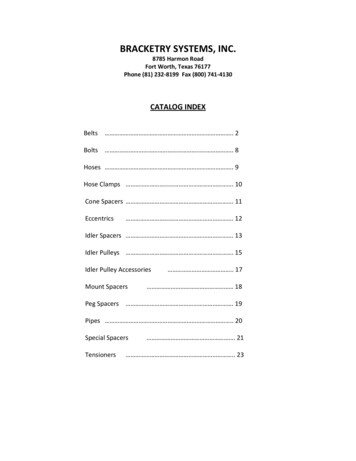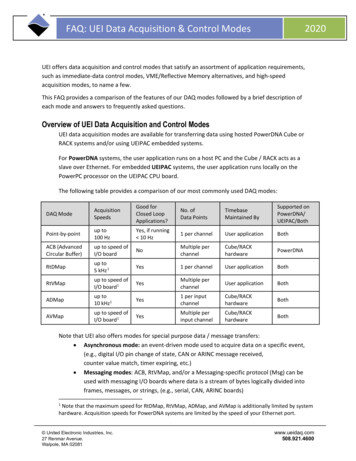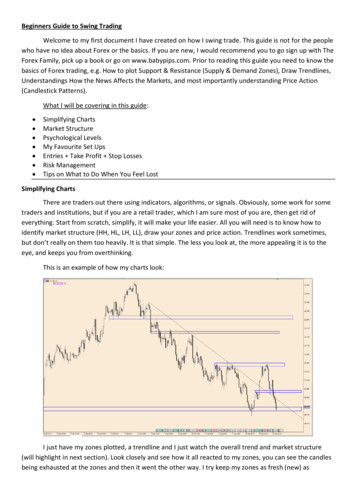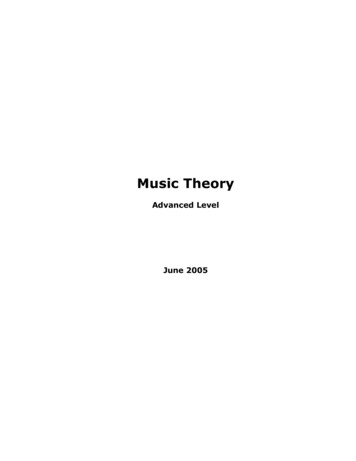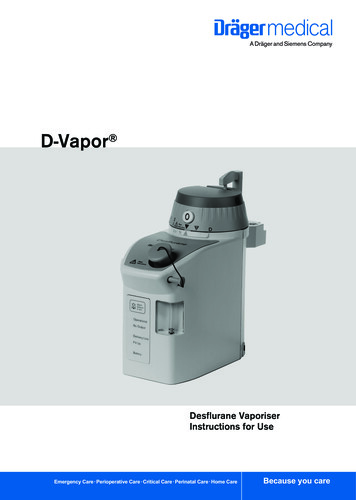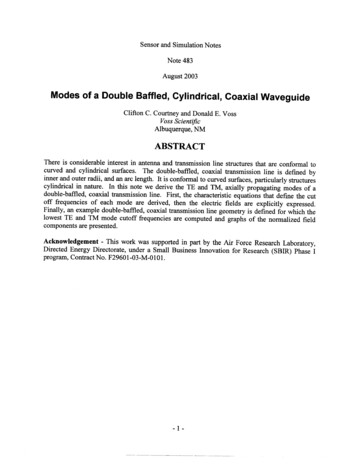
Transcription
Modes of a Double Baffled, Cylindrical, Coaxial WaveguideClifton C. Courtney and Donald E. VossVoss ScientificAlbuquerque, NMThere is considerable interest in antenna and transmission line structures that are conformal tocurved and cylindrical surfaces. The double-baffled, coaxial transmission line is defined byinner and outer radii, and an arc length. It is conformal to curved surfaces, particularly structurescylindrical in nature. In this note we derive the TE and TM, axially propagating modes of adouble-baffled, coaxial transmission line. First, the characteristic equations that define the cutoff frequencies of each mode are derived, then the electric fields are explicitly expressed.Finally, an example double-baffled, coaxial transmission line geometry is defined for which thelowest TE and TM mode cutoff frequencies are computed and graphs of the normalized fieldcomponents are presented.Acknowledgement - This work was supported in part by the Air Force Research Laboratory,Directed Energy Directorate, under a Small Business Innovation for Research (SBIR) Phase Iprogram, Contract No. F29601-03-M-OIOl.
The double-baffled, coaxial transmission line is defined by inner and outer radii, and an arclength, and can be conformal to curved surfaces and cylindrical structures. This note describesthe propagating modes of a coaxial waveguide transmission line with two baffles, withpropagation assumed in the z-direction. First, the characteristic equations that define the cut offfrequencies of each mode are derived, then the electric fields are explicitly expressed. Finally,an example geometry is defined for which the lowest TE and TM mode cutoff frequencies arecomputed and graphs of the normalized field components are presented.2.GeometryThe geometry of the double baffled, coaxial waveguide transmission line is shown in Figure 1.Note that the arc between the baffles has an angular extension of cP CPo'
BaffleIyThe geometry of the double baffled cylindrical coaxial waveguide: (a) 3-Dperspective drawing; (b) plane view 0 the xy-plane; and (c) plane view of thexz-plane.3.Wave EquationThe natural coordinate system for the coaxial waveguide transmission line with two baffles is thecylindrical coordinate system. The scalar Helmholtz wave equation in cylindrical coordinates is.!- (P 8pP8If/(P,CP,Z)]8p2 1 8 If/(p,cp,z)p228cp2 8 If/(p,cp,z)8z2 k2(If/)P,cP,z -0 (1)
where: Ij/(p,ep,z) R(p) D(ep)Z(z),and k k; e.4.Boundary Conditions5.Solution of the Separated Wave EquationThe D(ep) and Z(z)equations are harmonic equations with harmonic functions as solutions;these will be denoted h(nep) and h(kzz) .The equation in R(p) is a Bessel equation, and has Bessel function solutions: the Bessel function of the first kind of order nN (k pP ) the Bessel function of the second kind of order nH I)(kpp) the Hankel function of the first kind of order nH 2)(kpp) the Hankel function of the second kind of order nIn(kpp)nLet the function Bn(kpp) represent the linearly independent combination of two of the above.Then, the general solution to the scalar Helmholtz wave equation is:6.TEz and TMz Field Components
The electric and magnetic field components can be written in terms of fields that are TEz andTMz.The TMz field components are found by letting A uzV/, where A the magnetic vectorpotential, and Uz unit vector in the z-direction. Then.IE -JmA -V'(V'·A),mJlsand H -1 V'x A .Jl1E ----(6a)jmJls opozPPE1 1 02V/------'P(6b)jmJls p orp OZ1 (8'- e JE -z jmJls .!.-.!.0 V/H02V/OZ2V/(6c)Jl P orp(6d)H .!.OIfl1'PJl op(6e)Hz 0(6f)The TEz field components are found by letting F uzV/ , where F the electric vector potential,and Uz unit vector in the z-direction. Then1E --V'xF,Sand H -jmF -.-1-V'(V'.F).JmJlsE .!.!.oV/PSP orpE .!.oV/'PS op(8a)1H ----jmJls op OZP(8b)02V/H1 1 02V/------'PjmJls P orpoz(8d)(8e)
7.Solution of the Separated Wave Equation Subject to theBoundary Conditions of the Generalized GeometryPropagating waves in the z-direction in the double baffled coaxial waveguide give rise toh(kzz) e-ikzzThe harmonic function h(nrp) can be written ash( nrp) an sinenrp) bn cos( nrp)Note that n is not necessarily an integer. The scalar wave function is thenIJfkp,n,kz Bn(kpp)h(nrp)e-ikzZsubject to the boundary conditions. The solutions for the TEz and TMz modes in the guide are asfollows.Ep (- j J(kp)E (- kz)(n)rpJWJ.l&Ez . 1 (JWJ.l&h(nrp)is satisfied if: an 1,B (kpp)h(nrp)e-ikzZJWJ.l&Irp o,'Po1 Bn(k p)h'(nrp)e-ikzzPpe -k; (an sin(nrp)bn 0, n mtrrpo)Bn(kpp)h(nrp)e-ikzZ bn cos(nrp)), and mIrp o,rpo 1,2,3, . 0
Note that B Ckpp) dBnCkpp).dCkpp)The general Bessel function, BnCkpp),boundary conditions ifanJnCkpPl) bnNnCkpPl) 0anJnCkpPZ) bnNnCkpPz) 0NnCkpPz)NnCkpPl)JnCkpPz)JnCkpPl)also satisfies the
The convention for the zeros of the Characteristic Equation is P PI'pz, P3' . , where the PI isthe first zero solution, pz is the second solution (with increasing numerical value, and so forth).The TMz field components are then found explicitly as:(l7b)(l7c)
dd rp h( nrp ) !!-.(an sinenrp) bn cos( nrp» 1,. 0drp19' 0,9'0'I' n( an cos( nrp) - bn sinenrp»is satisfied if: an 0,19' 0,9'0,n ''1'0 0bn 1, n mtr , and m 1,2,3, .rpoThe general Bessel function, B n (k pp), also satisfies the boundary conditions ifddp Bn(kpp) 0Ip Pl,P2anJ (kpPl) bnN (kpPl) 0anJ (kpP2) bnN (kpP2) 0Substitution into the second equation yields:anJ (kpP2) bnN (kppJ -bnpP1N;(k )In(kpPl)J (kpP2) bnN (kpP2)N (kpP2)N (kpPl)J (kppJJ (kpPl) 0
kIIF."pk- [ N (k p) - N (k pPI) J (k pP )] cos ( nrp) e-ik,z , fior n -- -,mJrnpJ' (k) nnpPIrpo,n, ,k k;m -- 1, 2 , 3, . , an d kZ Again, the convention for the zeros of the TE Characteristic Equation is P PI' pz, P3" . , wherethe PI is the first solution, pz is the second solution (with increasing numerical value, and soforth. The TEz field components are then found explicitly as:E -!-[Np(kncPpP)- N (kpPl) J (k )]sin(n )e-ik,ZJ' (k) n pPrpnpPI-k k [ N (k p) N'n (k pp)I J (k p) ] cos(nrp)e-1k,Z.H Z Ppp(j)J1cH !!-[Nrp(j)J1c(kPnpPJ (kpPl)P)- N (kpPl) J (k )]sin(n )e-ik,ZJ' (k) n pPrpnpPINote that the Characteristic Equations for the TE and TM mode are similar, but not exact, to theforms given in [Ref. 2]. The reason for the differences is at this time unknown.Determine the first few cutoff frequencies of the TE and TM modes of a Double Baffled,Cylindrical,CoaxialWaveguidedefinedby the parameters:PI 5 in 0.127 m ,pz 6in 0.1524mand rpo 2Jr /3.
The cutoff frequencies for the first few the TE and TM modes have been computed and arepresented in Table 1 and Table 2 below.Cutoff frequencies (GHz) of the TE modes of a double baffled, coaxialwaveguide (PI 5in 0.127 m, P2 6in 0.1524m and (jJo 2Jr 10889311.817911.851611.9074Cutoff frequencies (GHz) of the TM modes of a double baffled, coaxialwaveguide (PI 5in 0.127 m ,P2 6in 0.1524m and (jJo 2Jr 9021317.711117.733517.7707The characteristic equations for the TEll and TMII cases are plotted in Figure 2a and c. Thecharacteristic equation for the TElp mode is plotted in Figure 2b showing the first 3 roots thatcharacterize the first 3 modes. Note that the radial gap between the conductors is I-inch, about of the freespace wavelength of the 1st TM cutoff frequency. And the median arc lengthbetween the inner and outer radii is 11.52 inches, about of the freespace wavelength of the 1stTE cutoff frequency.TEModes4c0i tr2WUU'C:0Gl1:) -2 (.)-40(a)102030kp4050
f------c:oiii::I2-0----;DI\) "l:J"W Jlliv.)"llr IIIIii -2.s:::.U"i-v""150kpTM ModesI50.05l:J"0.025gwu:;j 0"-ijU -0.025;Q-0.05II-0.075IIPlots of the Characteristic Equation for the double baffled, coaxialwaveguide transmission line (n 1): (a) TEll mode; (b) TE1p, for pmodes; and (c) TMll mode. 1,2,3Plot the electric field components over a cross section of the guide at a frequency that is 1.2times the cutoff frequency of the lowest mode.mJrFor m 1, n -CPo -- Jr 1.5.2Jr /3mJrJrFor m l, n - -- 1.5.CPo2Jr / 3For the TMll mode: fcFor the TEll mode: fc 513.00MHz.Then, compute the field distributions atf 1.2x fc 1.2x 5.921 7.105 5.921 GHz.GHz.f 1.2 x fc 1.2x 513.00 615.6MHz and
The wavelength at the operating frequency of the guide for the TEll mode, / 615.6 MHz, inthe axial direction of the guide, Ag, is defined as Ag 2:r 2:r- 0.881036 meters, wherekz 7.13159kz e -k .1 7 . 105The wavelength at the operating frequency of the guide for the TMII mode,. th e aXla. I d·IrectlOn.GH Z, ill0f IS.th e gul·d e, /l,g' g -/I,2:r - --- 2:r-- 0.076347kz 82.2978Normalized distributions of the electric field components of the TEll mode of the double baffledcoaxial waveguide for PI 5in 0.127m,P2 6.0in 0.1524mMHz are shown in Figure 3(a) Ep((PI P2)/2,cp);"CPo 2:r/3and 1 615.6(b) E p((PI pJ/2,cp),and Ez O.Normalized distributions of the magnetic field components are shown in Figure 4. SinceJ s x H , we can plot the current density on the interior surfaces of the waveguide. Shown innFigure 5 is a vector plot of the current density of the TEll mode at / 615.6 MHz on theP P2 , 0 cP CPo 2:r 13 surface.Normalized distributions of the electric field components of the TMll mode of the double baffledcoaxial waveguide for PI 5in 0.127m,P2 6.0in 0.1524m,CPo 2:r/3, and / 7.105GHzareshowninFigure6(a)Ep((PI P2)1 2,cp);(b)E p((PI P2)1 2,cp);and(c)Ez((PI pJ/2,cp).0.0120.80.010.6.:a- 0.006-0.008i&-0.40.0040.20.00200020406080; - degrees100120020406080; - degrees100120(a)Normalized distributions of the electric field components of the TEll mode ofthe double baffled coaxial waveguide (PI 5in 0.127 m,P2 6.0in 0.1524m,CPo 2:r /3, and / 615.6 MHz):Ep((PI pJ 12,cp); and (b) E p((PI P2) 12,cp). Ez O.(a)
0.0080.60.50.006. . .::? 0,-1006080degrees120(c)Normalized distributionsof the magnetic field components of the TEll mode ofthe doublebaffled coaxial waveguide(PI 5in,(a) Hp;(b)Hz.H9 ;and(c)P2 6.0in,(jJo 2Jr/3,and1 1/ /. /. / ./" I.I./'"""'-.-----"'".-----"'".------"'".- 4 /// ! I !' /' /' /"./".--/4 / P"-- .-----"'".------"'" MHz):----- 4 .----- 44., ., .t" , , y "" 1 615.6 . . . . . ",, , j il////// ---- --'· I; I; 1 y -, " "I' / 6"------ --4---------- !4,,,j"" / 6"6"il////// ---- ··. 4t I I / / / / / .----------.-------------.--------- -- ·90angle - degrees100Vector plot of the current density ofthe TEll mode atP P2 , 0 {jJ {jJo 2Jr / 3 surface.1 615.6MHz on the
0.01750.050.0150.040.0125;&-0.01 0.030.00750.020.0050.010.0025o0406080 - degrees1000120406080 - degrees100120(a)0.6 -0.420406080 - degrees100120Normalized distributions of the electric field components of the TMll modeofthe double baffled coaxial waveguide (PI 5in, P2 6in, f/Jo 2;r /3, andf 7.105GHz): (a) Ep; (b) Erp; and (c) Ez Contour and 3D projection graphs of the normalized distributions of the electric fieldcomponents of the TM11 modes of the double baffled coaxial waveguide for PI 5 in 0.127 m,P2 6.0 in 0.1524 m,f/Jo 2;r /3, andf 7.105GHz) are shown in Figure 7. Likewise, plotsof the normalized distributions of the electric field components of the TEll mode of the doublebaffled coaxial waveguide are shown in Figure 8 for f 615.6 MHz
0.04IEl6 INormalized distributions of electric field components of TMll mode ofdouble baffled coaxial waveguide (PI 5in 0.127 m, P2 6.0in 0.1524m,rpo 2:r /3, andf 7.105GHz): (a) Ep; (b)E9'; and (c) Ez
Normalized distributions of electric field components of TEll mode of doublebaffledcoaxialwaveguide(PI 5in 0.127m,P2 6.0in 0.1524m,q:Jo 2Jr /3,andf 0.6156GHz): (a) Ep; (b)Eq ; and (c) Ez Finally, the form of the next higher order mode is of interest. Referring to Table 1, the nextpropagating mode is the TE21 mode, with a cutoff frequency of Ie 1.02589 GHz. The non-zeroelectric fields at P PI P2 , as a function of q:J are plotted in Figure 9.2
0.0250.020.80.60.015Lfrw- -0.40.20.010.005000406080 /- degrees1001200406080100120 /- degrees(b)(a)Normalized distributions of the electric field components of the TE21 mode ofthe double baffled coaxial waveguide (PI 5 in, P2 6.0 in, CPo 2;r /3, andf 1.3MHz): (a) Ep; and (b) Erp. Ez o.1. Time Harmonic Electromagnetic Fields, R. Harrington, pg. 199, McGraw-Hill, NY,1961.2. Encyclopedia of Physics, ed. S. Flugge, pg. 345, Springer-Verlag, Berlin, 1958.
The geometry of the double baffled cylindrical coaxial waveguide: (a) 3-D perspective drawing; (b) plane view 0 the xy-plane; and (c) plane view of the xz-plane. 3. Wave Equation The natural coordinate system for the coaxial waveguide transmission line with two baffles is the cylindrical coordinate system.
